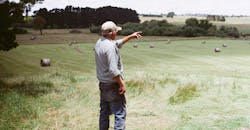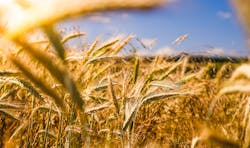Farming has always been a tough business. It’s also an important job, delivering food and resources to feed the world's population. Unfortunately, farming today means keeping up with changing food preferences, following government regulations and competing with sprawling cities and residential developments for prime land. As such, farmers need to be innovators, willing to adapt their livelihood to remain successful and sustainable for future generations.
This is where forward looking equipment producers like Moline, IL-based Deere & Co, manufacturers of the iconic John Deere brand, can make a significant difference. “Our role is to design and deliver more efficient, smarter and automated machines enabling farmers to tend to every square foot on the ground,” says Joel Hergenreter, manager of program management at John Deere's Intelligent Solutions Group. “When we look at every square foot, we can then start to nurture those plants individually to allow them to reach their fullest potential. That takes a combination of providing the nutrients to grow while also eliminating any pests that inhibit growth.”
Planting the seed
Deere made its first serious entry into the high tech space with the 1999 acquisition of NavCom Technology. At the time NavCom was one of the few companies with GPS capabilities including worldwide coverage and differential corrections. The GPS receiver allowed Deere to start driving equipment automatically through the field, meaning farmers could lay a virtual line down for the tractor, combine or sprayer to follow. “This type of automation allows operators to focus on other aspects of farming with more diligence to the actual job the machine is doing as compared to driving the equipment,” says Hergenreter.
Deere has since embraced other technologies such as machine learning (ML) and artificial intelligence (AI). For instance, in June, it released the X9 Combine. The harvester uses AI/ML combined with real time data gathered through sensors, cameras and processors to automatically set machine parameters. “As this rolling factory drives through the field, it automatically makes adjustments to optimize the grain going into the bin and ultimately our food sources,” he says. “It ensures that we're not damaging the harvest and we are cleaning it to the best of the machine's ability.”
In 2017, Deere acquired Blue River Technology, noticeably expanding on its AI capabilities, such as being able to target and only spray a specific type of weed. This means farmers are only putting chemicals where needed rather than spreading them across the entire field.
“We have machines running in the field today with cameras and processors collecting images (roughly 300,000 to-date) taking into consideration different lighting conditions, angles and weed maturity levels, and then transmitting them back to our cloud to serve as a library,” says Hergenreter. “As the machine goes through the field, it compares what it sees to whats in the library. As a result, we're seeing chemical reductions of up to 80% for certain applications.”
Adding nourishment
Deere is now at the point where technology is in its DNA.
“How we operate and the fabric of how we deliver products focuses heavily around our ability to make the most of technology. The John Deere Intelligence Solutions Group is here to bring the tech stack to the rest of the enterprise,” he says. “We have over 800 software developers, machine learning scientists, systems engineers, data analysts and user experience professionals all focused on bringing these technologies to life. We spend a lot of time working to understand the problems farmers deal with and we're constantly iterating along the way to deliver solutions.”
“The launching of X9 Combine uses AI to look at each individual grain and make sure we're not damaging the kernels of grain themselves, maximizing the value of the product farmers worked all year to produce,” he says. “Constantly evolving technology means rather than mass adjustments, we're now down to finite adjustments similar to how Lego has visual inspection of every Lego generated, we were generating healthy crop using cameras and sensors to look at every kernel.”
Recognizing and eliminating "pesty" problems
Farms are rarely ideal environments for technology. However, Hergenreter tells IndustryWeek there are three primary challenges John Deere faces as it continues integrating technology into its equipment.
Rural connectivity. Connectivity is important to rural communities, not only for farmers to stay connected to understand how the markets are changing or what the weather impacts are going to be, but also for connected equipment. Knowing that connectivity can be limited in rural communities, Deere has integrated 4G modems onboard its equipment. Connectivity provides data a route into the John Deere cloud. Data that can enable the formation of digital twins, or serve as core data enabling farmers to analyze and understand their operations better.
“As the amount of data coming off machines continues to increase, it can play a meaningful role in guiding product design. By having all of these machines connected, we can pull in digital threads to create digital twins and better understand the use cases,” he says. “Plus, we can proactively predict when a failure is going to occur and send a needed part. We can also use the data to define our equipment to better meet their needs.” According to Hergenreter, seemingly little things like understanding exactly how big of a fuel tank the average farmer needs can play a role in continually creating equipment better suited to real world applications.
While some of the technologies align with those used in automobiles, Hergenreter says his team is very cautious when adopting anything new. “A lot of the technologies are common, but you get a layer deeper, and that's where, where the use cases diverge. We have to design a lot of these systems to be more robust to the operating environment,” he says. “For instance, instead of just stopping, if our technology sees something in its path, it needs to quickly determine if it is something to stop for or something that it actually needs to run through the machine.”
Maintaining proper focus. “Rather than leading with technology, we need to make sure we're developing the right product for the farmer,” he says. “We always strive to make sure we truly understand the customer's product, so we avoid situations where we are delivering the technology and then looking for a solution.”
Improving the harvest
Whether a farmer is tilling, planting, spraying or harvesting, John Deere has equipment that delivers that operation potentially creating a dynamic system. “We know the planter that put the seed in the ground can digitally inform the sprayer on how to improve its operation. For instance, the planters can tell the sprayer to be prepared to see ragweed in a specific area,” he says. “We have the ability to share hundreds of parameters from machine to machine with the goal of improving the cycle of operations.”
Of course, when collecting, storing and analyzing data it quickly becomes large data -- and it is edge computing that continues to be the best solution. “We know 5G is coming, and it has a lot of promise, but it is in the distant future for rural America,” he says. “Until then, edge computing with advanced sensors will still be very core technology for us to sense and act on a lot of the operations that we need to do on the farm.”
Plus, farmers remain a key sensor, explains Hergenreter. “They know the land and the operations better than anyone. We have to be able to use their eyes, and all of their senses, to help inform us when the operation is going right, and when it needs an adjustment,” he says. “For instance, to continue improving weed identification, we are going to continue to work with our farmers as a crucial part of the feedback loop, helping us teach the system.”
About the Author
Peter Fretty
Technology Editor
As a highly experienced journalist, Peter Fretty regularly covers advances in manufacturing, information technology, and software. He has written thousands of feature articles, cover stories, and white papers for an assortment of trade journals, business publications, and consumer magazines.

![X9 M2 M[1] X9 M2 M[1]](https://img.industryweek.com/files/base/ebm/industryweek/image/2020/08/x9_M2M_1_.5f374f68e6602.png?auto=format,compress&fit=max&q=45?w=250&width=250)
![X9 Remote[1] X9 Remote[1]](https://img.industryweek.com/files/base/ebm/industryweek/image/2020/08/x9_remote_1_.5f374f67708da.png?auto=format,compress&fit=max&q=45?w=250&width=250)
